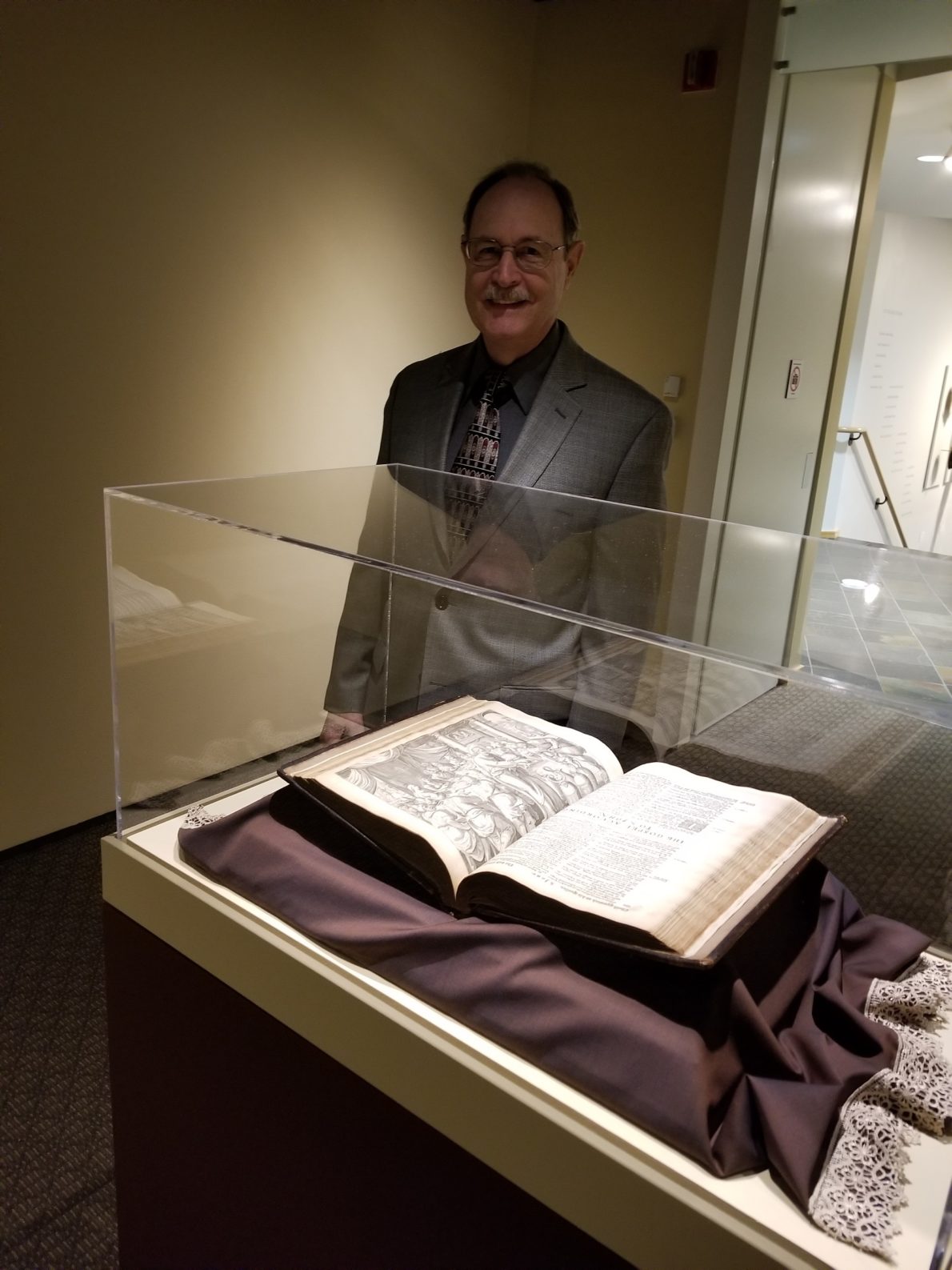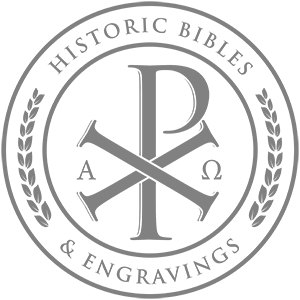Yesterday, February 10th, 2018, a date that shall live in inf… err, my memory, the Hexham Abby Bible made its long awaited debut to the world. Working with the Hallie Ford Museum of Art (Salem, OR), in conjunction with Willamette University and Professor Ricardo De Mambro Santos, has been a sheer joy, and all parties involved lived up to, and exceeded, my expectations.
I was impressed to see the Hexham Abbey Bible tastefully and elegantly encased in protective acrylic, a sight that took my breath away and substituted a certain “pride” (if I may) in all the hard work leading up to this point. And the 35 engravings, all so well framed, made its impact so much more profound. I must say, that the engravings look like real museum art in their frames so much more than as loose pictures. Dr. De Mambro Santos and his students did a splendid job with all the documentation and descriptions for each of the engravings.
On March 14th, I will present a lecture on the discovery, provenance, and theological import of the Hexham Abbey Bible. I know I have my work cut out for me!
A very warm “thank you!” to everyone who participated in making the Exhibit work, from the museum’s Director to the framers and photographers to the catalogue printers to the exhibit docents. Great work, everyone, a joint effort that all of you made seem effortless (to me). My hand was very small compared to theirs. I am also impressed by the great many people who have found the Exhibit a blessing to them.
Soli Deo Gloria





2 Responses to "Debut Exhibit of the Hexham Abbey Bible"
Dr Martin,
I went over to the Hallie Ford Museum today to see the exhibit. It truly is a most remarkable find, and its presentation is both attractive and instructive. An exhibit like this invites more questions, of course, than it answers, though the answers given as to provenance and chain of ownership were very helpful. The format, in which one could sample probably around 80% of the engravings, was also terrific. Among the questions or thoughts that invite further examination are: 1) If there are about 110 engravings inserted in the text (and it is unclear to me whether 2 on the same page in Matthew’s Gospel constitute one or two in your counting system), then I counted 39 from Matthew and another 31 from Acts…leaving probably a bit over 40 from the other three Gospels combined. I wonder if there was a theological bias towards Matthew that is thereby reflected in its very large number of engravings? 2) Do we know if the images inserted were just those that the Abbot/Leader of the Monastery could find or did they reflect a particular theological interest? Thus, the question as to purposiveness vs randomness seems relevant. 3) The Bible was printed in Cambridge in 1629; I assume it is the Authorized Version translation, though I don’t think that is ever mentioned. It might be good to know about how many AV Bibles were printed by that time, and what other translations might have been in circulation and the nature of their distribution (were they only meant for abbeys/cathedrals/parishes or did many individuals own them?) 4) There is a slight ambiguity as to what is in the Bible– I think it is only Psalms and NT and BCP, without the OT…though when I have read things suggesting it is the “Bible,” that might lead to other conclusions. Was that a normal printing pattern for Bibles of that era? Was the threefold BCP/Ps/NT as popular or more popular than OT/NT? 5) In the 31 or so images from the Book of Acts, there is one mistake. Someone has inserted a print probably from a philosophical book published in the 1650s..but it definitely is not a Bible passage. I look forward to returning to the exhibit to glean additional information.
Dr.Long,
Many thanks for your incisive comments and questions! Some of them are answered in my other blogs and lecture, but I’ll attempt to summarize here:
1a) There are 118 engravings in the Bible, 10 of which are double engravings, making a total of 110 full pagers. They range in date from 1568 to 1643. 1b) A quick and perhaps not accurate count of the engravings, by book, is: Mt 34, Mk 4, Lk 19, Jn 12, Ac 33, Ro 2. This comes to 104 instead of 108, so I’m not sure what I’m missing since I don’t have the Bible in front of me. Mt is of course the longest Gospel, Mk is the shortest, and Ac has the full set of Strandanus’ prints plus some.
2) Personally, I doubt if there is a bias for Matthew. I think it more likely that the compilation was a rush-job and Ritschel took from his stock what he had on hand. I think that Ritschel was purposeful in inserting the prints before the stories (most engravings have biblical citations on them already), but also there is some randomness or hurriedness to stacking a lot of prints at the beginning; for example, there ate seven prints prior to Mt 1 where Rirschel could have spaced them out a bit. Interesting is what Ritschel left out . . . see further below.
3a) The Cambridge 1629 Bible is a King James or Authorized Version, as all the Cambridge editions are at this time. This particulat edition was chosen, I presume, because of its proper size and also because the paper matches that of the engravings, a perfect fit! 3b) Ritschel chose the AV rather than the Geneva because he wanted to emphasize his Anglican bona fides not only as to version but with the addition of prints. Although the 1629 Cambridge was designed for church usage, it quickly became a favorite of individuals as well. There are no records of the numbers of copies of bibles printed each year, but for the 1629 Cambridge bibles were printed on seven different types of paper, one of which matched Ritschel’s needs exactly; and I don’t know of any other English bible that used that type of paper.
4) Normally, all bibles printed in England at that time contained the BCP and Whole Book of Psalms, as well as the OT, Apocrypha, and NT. The Hexham Abbey Bible consists of the BCP, NT, and the Whole Book of Psalms set to English Meeter — in other words, it is a worship book. It lacks the OT and Apocrypha. Interestingly, Cambridge did not offer just a NT that year, so Ritschel must have taken out the OT and Apocrypha in order to create a worship book. It may be that there is an OT out there somewhere with engravings in it! Personally, though, I doubt it since the Hexham Bible displays evidence of a rush job, or an incomplete work that was shelved, perhaps as yet unbound, when the new 1662 BCP was printed.
5) The strange engraving you are referring to in Acts is the one titled “The Spirit of Science”. from a 7-print series titled “The Gifts of the Holy Spirit”. Of course, nowhere in the NT is “science” a gift of the Spirit. But for Ritschel, it all depends on what one means by “spirit”. Other strange engravings is the one that depicts the Roman gods Bacchus and Venus at a banquet table. According to Dr. Ricardo De Mambro Santos, this would not have been strange to Ritschel, if he even cared, because these Roman gods and pagans in general were thought of as “proto-Christians.” Yet another strange engraving is that of Peter “repenting” of his sins. This was part of a series of many “saints” repenting, and thus showing their faith.
I have also noted that Ritschel omitted some very important images that he could certainly have inserted. There is but one half-page engraving of Jesus’ resurrection (the other half is Jesus’ burial), and there are no engravings of any post-resurrection appearances, no engravings of the Ascension or of the Last Judgment. This leads me to believe that Ritschel did not believe that Jesus rose from the dead. For Ritschel, as for many others at the time (and after!), Jesus was a great teacher and miracle-worker, the epitome of a righteous and ethical man. Perhaps Jesus had some god-given powers, but he was not God-in-the-flesh whose crucifixion was the culmination of his ministry — an idea only possible if Jesus was raised from the dead. Peace and Joy!